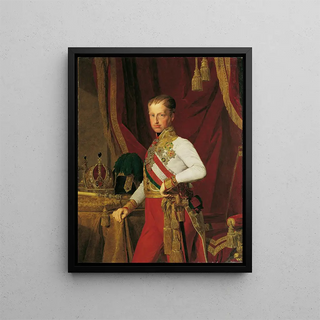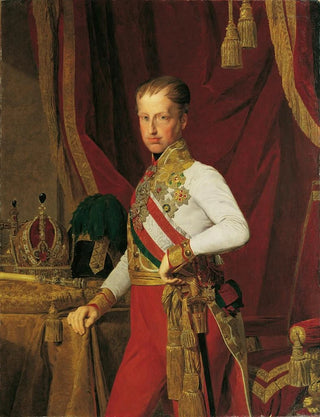Art print | L'empereur Ferdinand Ier d'Autriche - Ferdinand Georg Waldmüller


View from behind

Frame (optional)
Art print of Emperor Ferdinand I of Austria - Ferdinand Georg Waldmüller – Captivating Introduction
Within the rich and diverse panorama of 19th-century Austrian art, the work "Emperor Ferdinand I of Austria" by Ferdinand Georg Waldmüller stands out for its historical depth and visual brilliance. This emblematic representation of a sovereign, both majestic and intimate, captures the essence of an era marked by political and social upheavals. Through the painter's gaze, the viewer is invited to immerse themselves in an atmosphere where royal dignity blends with palpable humanity. Waldmüller does not merely depict a figure of power; he offers a reflection on the individual behind the throne, revealing nuances of personality and the challenges of his reign.
Style and uniqueness of the work
Waldmüller's style is characterized by striking realism, where every detail is carefully crafted. In "Emperor Ferdinand I of Austria," mastery of light and shadow plays a crucial role, giving the canvas an almost sculptural dimension. The drapery of the imperial attire, richly decorated, is rendered with such precision that it seems to come alive under the artist's brush. The colors, both vibrant and nuanced, testify to a refined palette, where each hue is chosen with care to evoke nobility and gravity of the subject. This painting, far from being a simple representation, transforms into a lively scene where emotion and solemnity meet, allowing the viewer to feel the presence of the emperor beyond the frame.
The artist and his influence
Ferdinand Georg Waldmüller, a major figure of Austrian Romanticism, knew how to mark his era with a style that combines tradition and innovation. Trained in the ateliers of great masters, he developed a unique approach that influenced many contemporary artists. His ability to capture the soul of his subjects, whether they are historical figures or portraits of everyday life, earned him lasting recognition. Waldmüller is not limited to portrait painting; he also explores themes of the

Matte finish

View from behind

Frame (optional)
Art print of Emperor Ferdinand I of Austria - Ferdinand Georg Waldmüller – Captivating Introduction
Within the rich and diverse panorama of 19th-century Austrian art, the work "Emperor Ferdinand I of Austria" by Ferdinand Georg Waldmüller stands out for its historical depth and visual brilliance. This emblematic representation of a sovereign, both majestic and intimate, captures the essence of an era marked by political and social upheavals. Through the painter's gaze, the viewer is invited to immerse themselves in an atmosphere where royal dignity blends with palpable humanity. Waldmüller does not merely depict a figure of power; he offers a reflection on the individual behind the throne, revealing nuances of personality and the challenges of his reign.
Style and uniqueness of the work
Waldmüller's style is characterized by striking realism, where every detail is carefully crafted. In "Emperor Ferdinand I of Austria," mastery of light and shadow plays a crucial role, giving the canvas an almost sculptural dimension. The drapery of the imperial attire, richly decorated, is rendered with such precision that it seems to come alive under the artist's brush. The colors, both vibrant and nuanced, testify to a refined palette, where each hue is chosen with care to evoke nobility and gravity of the subject. This painting, far from being a simple representation, transforms into a lively scene where emotion and solemnity meet, allowing the viewer to feel the presence of the emperor beyond the frame.
The artist and his influence
Ferdinand Georg Waldmüller, a major figure of Austrian Romanticism, knew how to mark his era with a style that combines tradition and innovation. Trained in the ateliers of great masters, he developed a unique approach that influenced many contemporary artists. His ability to capture the soul of his subjects, whether they are historical figures or portraits of everyday life, earned him lasting recognition. Waldmüller is not limited to portrait painting; he also explores themes of the






